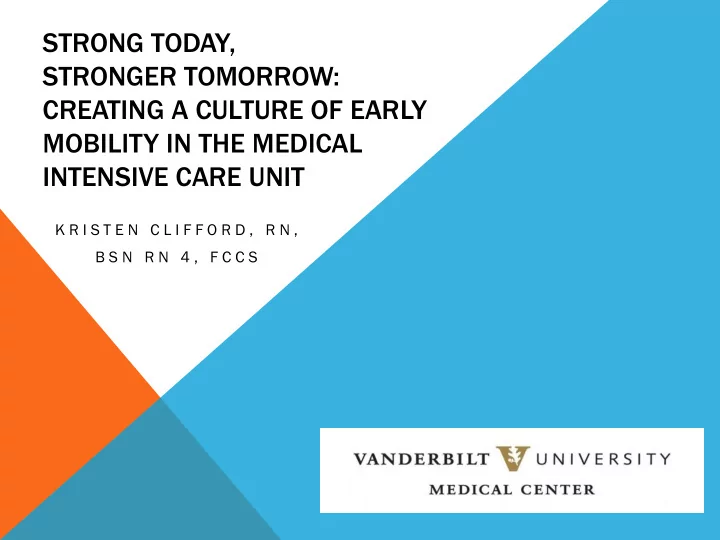

STRONG TODAY, STRONGER TOMORROW: CREATING A CULTURE OF EARLY MOBILITY IN THE MEDICAL INTENSIVE CARE UNIT K R I S T E N C L I F F O R D , R N , B S N R N 4 , F C C S
KRISTEN CLIFFORD BIO • B.S.N .N Oa Oaklan land d Un Univ iversi sity ty • Rochester, Michigan • Regist ister ered ed Nurse se 4, Medical ical ICU CU • 9 Years • Qu Quali lity ty Improvement ent Analyst lyst (Q (QIA) A) • 1.5 years
VANDERBILT UNIVERSITY MEDICAL CENTER • Nashvil ille le, , TN • 1,0 1,000+ 00+ Beds ds • 2 mil illion ion encoun unters per year • Level 1 Trauma • Medi dical ICU • 35 beds
WHAT IS A QIA?? • Chart reviews/debriefs and Event Analysis • C.diff • CLABSI • CAUTI • Falls • Hospital wide committees/projects • Unit based quality improvement projects • Unit Rounding on Quality Bundle Compliance • Staff Education • Research – EBP to bedside
WHY EARLY MOBILITY? • Muscle strength declines 3-11% with each day of bedrest. • ICU Acquired Weakness (ICUAW) can start within the first few days of critical illness. • ICUAW can lead to immobility and result in loss of strength, endurance, and bulk. • Immobility contributes to poor performance on falls and hospital acquired pressure ulcers. Morbidity, mortality, length of stay (LOS) and cost of care may • be affected by ICUAW. • Developing a culture of early mobility as standard care can improve patient outcomes.
ABCDEF AND EVIDENCE BASED PRACTICE ABCDEF is a standard bundle of ICU measures that includes spontaneous…… Assessment for and manage pain Both Spontaneous Awakening Trials (SAT) and Spontaneous Breathing Trials (SBT) Choice of sedation and analgesia Delirium monitoring and management Early mobility Family engagement ICU Delirium and Cognitive Impairment Study Group Gordon R. Bernard, MD Nathan E. Brummel, MD, MSCI Timothy D. Girard, MD, MSCI E. Wesley Ely, MD, MPH
PURPOSE The purpose of this project was to increase early mobility and make it standard care in the Medical Intensive Care Unit (MICU) to improve patient outcomes through a campaign “Strong Today, Stronger Tomorrow MICU Early Mobility.”
STRATEGY AND IMPLEMENTATION • Awareness increased with Early Mobility Protocol, using Johns Hopkins Highest Level of Mobility (JH-HLM) Scale • Education created for all bedside nurses, care partners, respiratory, physical and occupational therapy. • Nurses presented patient’s mobility during morning rounds with ICU team to facilitate orders. To ensure patients were being mobilize, an early mobility tracker (JH- • HLM scale) was used to monitor daily mobility. (3 month time period) • This scale was completed during every shift. Educational handouts for families regarding passive ROM • Evaluation metrics include: 1) Staff perceptions of early mobility 2) Quality metrics of unit acquired pressure ulcers and falls. The campaign was launched in Nov 2016.
COMPLETE EARLY MOBILITY SURVEY • Email of the URL to link you to the survey 14 questions • (less than 5 minutes) 10
PRESENT MOBILITY IN AM ROUNDING WITH MD’S 11
EARLY MOBILITY TRACKER • Tracking sheet is to be filled out daily by day and night shift, just one simple line • Multidisciplinary – Filled out by Nursing and PT/OT 12
INSENTIVES FOR STAFF • Launch ch party y for day and nights htshif ift • Monthl thly y Mobility ility Cham ampion pion for 1 yea ear r – Au B Bon Pa Pain Gift t Card
RESULTS • Daily mobilization of 65.85% (349/550) 90 MICU staff responded to the baseline survey, 34 completed the 6-month • follow up. • There was an improvement in staff belief in ability to safely mobilize patients ( X 2 , p < .001) • Patients mobilized once a shift more often ( X 2 , P = .068). • Monthly fall and pressure ulcer rates declined post implementation. 1 year post implementation - Average patients mobilized once a shift - 88% •
# of MICU CU Falls s Pre and Post t Initi tiat ation on of Early Mobility ty 4 Initiation of Early Mobility November 2016 3 # of Falls 2 1 0 Months hs 2016 - 2017
# of MICU CU Pa Patien ents ts with HAPU Pre and Post t Initi tiat ation on of Early Mobility ty 3.5 Initation of early mobility (Nov 16th) 3 occurred after Survey 2.5 2 1.5 1 0.5 0
# of MICU CU HAPU FY 15 – FY 17 9 8 8 7 ers ure Ulcers 6 ssure 5 FY 15 4 4 # of Press 4 FY 16 3 3 FY 17 3 2 1 1 1 1 0 0 November December January Month th
IMPLICATIONS FOR PRACTICE Use of multiple strategies to improve a culture of Early Mobility was successful in hardwiring early mobility as standard care and increased ownership among nursing staff. These strategies (education, monitoring, reminders and feedback) may be used to improve other problems that affect patient outcomes. Printed with permission
MOVING FORWARD • Epic Documentation – John Hopkins Highest Level of Mobility (JH- HLM) Scale • Mosaic Study
QUESTIONS Kristen.Clifford@vumc.org ICUdelirium.org
Recommend
More recommend